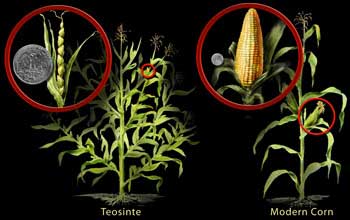Washington, DC
May 27, 2005
Indigenous
farmers bred the plant for hardiness and better food quality
 Researchers
have identified corn genes that were preferentially selected by
Native Americans during the course of the plant's domestication
from its grassy relative, teosinte, (pronounced "tA-O-'sin-tE")
to the single-stalked, large-eared plant we know today. The
study revealed that of the 59,000 total genes in the corn
genome, approximately 1,200 were preferentially targeted for
selection during its domestication. Researchers
have identified corn genes that were preferentially selected by
Native Americans during the course of the plant's domestication
from its grassy relative, teosinte, (pronounced "tA-O-'sin-tE")
to the single-stalked, large-eared plant we know today. The
study revealed that of the 59,000 total genes in the corn
genome, approximately 1,200 were preferentially targeted for
selection during its domestication.
The study, by University of
California, Irvine's Brandon Gaut and his colleagues,
appears in the May 27 issue of the journal,
Science.
Understandably, a primary goal of teosinte domestication was to
improve the ear and its kernels. A teosinte ear is only 2 to 3
inches long with five to 12 kernels—compare that to corn's
12-inch ear that boasts 500 or more kernels! Teosinte kernels
are also encased in a hard coating, allowing them to survive the
digestive tracks of birds and grazing mammals for better
dispersal in the wild. But, for humans, the tooth-cracking
coating was undesirable so it was selectively reduced…and
reduced…and reduced…until all that remains is the annoying bit
of paper-thin, translucent tissue that sometimes sticks between
the teeth when one munches corn on the cob.
To analyze the genes of modern corn and its ancestral teosinte,
Gaut and his coworkers used relatively new genomic techniques to
determine the DNA sequence of 700 gene bits in the two plants
and used "population genetics," the study of genetic variation,
to compare them.
"These results will provide important insights to modern corn
breeders in their quest to establish hardier, higher-yielding
corn plants," said Gaut. "The scientific approach will also be
useful in the study of other domesticated organisms, plants and
animals alike."
This work generally confirms the idea that corn went through a
"population bottleneck," or a period when a significant portion
of corn’s genetic diversity was lost, which typically marks a
domestication event. Calculations using these data reveal that
fewer than 3,500 teosinte plants may have contributed to the
genetic diversity in modern corn.
Between 6,000 and 10,000 years ago, Native Americans living in
what is now Mexico began domesticating teosinte, or the "grain
of the gods," as the name has been interpreted to
mean. Scientists cannot yet say how long this domestication
process took, but they do know that around 4,500 years ago, a
plant recognizable as today's corn was present across the
Americas.
So, thousands of years before Gregor Mendel postulated his
theories on genetics and heredity, indigenous Americans were
breeding corn to select for desirable traits. By selectively
breeding each generation, ancient farmers drastically changed
teosinte's appearance, yield, grain quality and
survivability—culminating in today's "corn." In fact, teosinte
is so unlike modern corn, 19th century botanists did not even
consider the two to be related.
"This is a very exciting finding," said Jane Silverthorne of the
National Science Foundation's (NSF) biology directorate, which
funded the project. "We are beginning to have a much clearer
picture of what happened to the genes responsible for the
structure of today’s corn plant."
A broad understanding of the genes present in modern-day corn
will provide a foundation for improving it as well as its cousin
cereal crops. Target goals include yield increases, improved
insect and pathogen resistance, enhanced environmental
adaptability, and improved nutritional value. To that end,
sequencing the entire genome of corn is also critical to
improving the crop and its value in human subsistence. To that
end, sequencing the entire genome of corn is also critical to
improving the crop and its value in human subsistence.
According to the U.S. Department of Agriculture (USDA), nearly
12 billion bushels of corn were harvested in the United States
in 2004, which will be used for a diverse array of products
including livestock feed, ethanol and plastic consumer items, as
well as food. The National Corn Growers Association reported
that 2003 corn exports were valued at $4.5 billion.
Supported by NSF's Plant Genome Research Program, this
collaborative project included Gaut and co-workers at the
University of California, Irvine, together with scientists from
the USDA-Agricultural Research Service, the University of
Missouri and the University of Wisconsin. NSF is part of an
interagency program along with the U.S. Department of Energy and
the USDA that plans to support the sequencing of the corn genome
over the next three years.
The National Science Foundation (NSF) is an independent
federal agency that supports fundamental research and education
across all fields of science and engineering, with an annual
budget of nearly $5.47 billion. NSF funds reach all 50 states
through grants to nearly 2,000 universities and institutions.
Each year, NSF receives about 40,000 competitive requests for
funding, and makes about 11,000 new funding awards. The NSF also
awards over $200 million in professional and service contracts
yearly. |